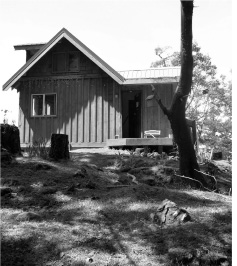
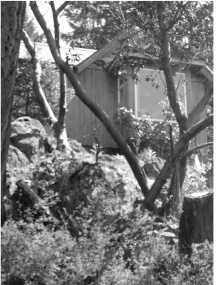
Home sweet home!
by Bronwyn Preece
This is my own story. It was the inspiration to begin compiling this book. I think of my birth as an absolutely amazing experience—a reaction that surprises some people. This stems from the fact that although I did birth at home, I required a helicopter evacuation about twelve hours following the delivery. This story was penned within a few weeks of Simi’s birth. Attached to it is a postscript that provides a later understanding of what caused the need for medical help. My birth remains a beautiful memory and so too does the follow-up care I received. This homebirth story journeys from moss to medical . . . or organic to obstetrical.


Home sweet home!
Similkameen Shannon O’Rourke was born at 4 a.m. on Good Friday the thirteenth at home, in a cabin built in anticipation of her arrival—and she was just perfect!
I was woken up at two in the morning by a strong contraction and a trickle between my legs. I got up to pee, and my waters broke. I knew this was the beginning of the real thing, as I had had a couple brief episodes of “false labor” the week before. In that early morning time, I remember popping on a light, and thinking, “Well, I better eat something, as I’m going to need a lot of energy.” I toasted a bagel, and ate it with the delight that it was somehow a ceremonious meal. I remember enjoying it and laughing at the bagel-eating-experience-like-none-other. Within fifteen minutes of that initial contraction, the flood of them began. They were immediately one minute apart—and right off the bat we were in the swing of things!
Paddy, my incredible partner, was up immediately when my waters broke, and started the woodstove. He called Anna, our dear friend and neighbor, who was over in ten minutes. He called our midwives as well. The house was abuzz! I was hoping to have a waterbirth (the pool was already inflated), but without a plumbed hot water system, our only way to make hot water was to boil it. Both Paddy and Anna got busy trying to heat water. Inside, pots filled the woodstove and the cookstove. Outside, Paddy had rigged an impressive system involving a large pot of water mounted on rocks, which he heated with a blazing propane tiger torch. Between the leaping flames, the roar of the torches, and the stream of phone calls being made (relaying information to our midwives, and trying to coordinate their boat trip across the waters to reach us), we were in a mode of exuberant cacophony!
This was our middle-of-the-night scene on the remote Lasqueti Island: an off-the-grid dot of land in BC’s Salish Sea. Here, in our new cabin—with no hot water, and power derived solely from a generator—my carefully arranged goddess candles, incense sticks, and compulsory melodic music were never touched. Neither was my camera. Rather, this fast-track labor turned us on to full-throttle mode. Paddy, in the midst of the water and other immediate preparations, was trying to figure out just when and where the boats we’d lined up for our midwives were!
Anna was wonderful in rubbing and applying pressure to my lower back. I was mainly walking around continuously—inside, outside, inside—repeatedly saying, “I really need to shit”—convinced that that was exactly what I needed to do, but couldn’t. I requested a bucket be arranged, as I was hesitant to use the outhouse, having horrible visions of possibly birthing my child into a pile of poop while defacting. A clean bucket it needed to be! At one point I remember I was on all fours, outside in the moist moss, and giggling at how absurd I must look, pregnant and moaning. “Well, you can’t get much more organic than this!”
At about 3 a.m., we decided to ask our neighbor Lily—an attendee of many births—to come over and help. This was completely impromptu, but we felt we wanted someone on hand who had experience in a birth environment. This choice was made simply out of logic, not fear. Our midwives were now driving toward French Creek—the mainland harbor they would leave from—having left another laboring mother, as they knew they were required more urgently with us.
With a mounting intensity, I kept practicing the most fabulous piece of advice I was given at my blessingway: “Keep loose lips, like a horse.” And did it ever help. I remember thinking (as I was logically trying to figure out what stage of labor I was in) that the intensity was now definitely a bit strong. About five minutes before my daughter was born, I had that flash of Oh my goodness, if this is what it’s like at the beginning, then I’m not sure what it will be like at the end!
At some point, I simply said, “Paddy, I really need you now,” and he came and stayed with me. Anna tried to take over the pool-filling duties, but that was quickly abandoned as we realized this baby was on its way . . . and quickly! I lay down on our bed, and Paddy and Lily could see that the head was crowning. I got right up, and went into a part squat/part leaning-over position, and the baby’s head came right out. I had not pushed once—the force of the contraction did it all. I was informed that the head was out when I heard Paddy say “That’s the head!” Anna rushed over saying, “What, you can see it?!?” “No, it’s out!” was his answer. This is when I felt down and touched the little head. We knew to watch for the baby’s body to turn slightly, which it did, and with the next contraction, in a deeper squat, and again without any pushing, her body came out—caught by Dad! My body had been on automatic pilot. I had not needed to consciously do anything extra. I birthed without a single push.
The baby was immediately brought up to my belly and we all climbed into bed with her. We had not even realized that we hadn’t checked if it was a boy or a girl, it didn’t seem to matter . . . until Lily could not stand it anymore, and declared, “It’s a girl!” After an hour and forty-five minutes of labor, we had a perfect little package nestling up to us!
Just then our midwives called (they were now at the harbor, but still on the other side), and talked us through the clamping of the cord (we did have some clamps with our prepared supplies). We did not clamp immediately—we waited until the cord stopped pulsating. What a magical experience, with all of us there imbued with such a loving energy. The experience of giving birth was certainly powerful, but it never felt painful to me.
Paddy directed our midwives over the phone to the dock where they would find the awaiting lime green, skull-and-cross-boned, essentially renegade pirate boat. They simply had to roust awake the captain, and, with the help of a man they found down on the docks, get past the guard dog and board an adventurous ride they will likely never forget.
I gave birth to the placenta about thirty minutes after the birth, with a great deal of grunting, as I was having no contractions. Meanwhile, we noticed that I had been bleeding a slow stream of blood. We elected to give me a shot of oxytocin (a supply we had been given ahead of time by our midwife “just in case”), a bunch of cayenne capsules (an old Mexican trick), and some nettle tincture. The bleeding slowed. It was a delightfully funny few moments when we were deciding who should administer the shot of oxytocin. It was Lily who finally was given that honor, winning out since she said, “Well, I’ve given my sheep a shot before.” There we had it: an expert in our midst!
The midwives were brought to our house at 6:30 a.m. When they arrived, all was well. They ended up giving the baby a bit of oxygen as she had the slightest blue tinge above her lip, but that was all. The bleeding seemed to be taking care of itself, and they left to catch the 11 a.m. ferry off-island. At that point, I was fine. The oxytocin had kicked in, and so what the midwives witnessed was not the full extent of my bleeding.
However, through the rest of the day, after the midwives departed, the bleeding began more steadily and continued on, and I began passing blood clots. In my jubilant state with my new daughter, I kept reiterating, “I’m fine.” And that’s exactly how I felt. I was thrilled. I was lavishing all my attention on her. My mum even came over on the morning ferry for a couple of hours, and left on the afternoon ferry. In hindsight, she kicks herself for not intuitively knowing that I was in need of help. But at that time, this was not registering with any of us: me, Paddy, Anna, our two midwives, or my mum.
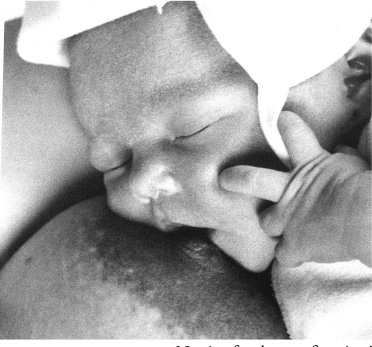
Nursing for the very first time!
Unfortunately, by 4 p.m., it became very apparent that I was not fine. I started having trouble sitting up without getting dizzy and faint. I had difficulty getting up to pee. By 5 p.m., I was nearly passing out, losing my vision, and my head was filled with the strangest crackling sound—my head just felt empty. We needed to evacuate—and fast!
Paddy called our midwife, who was now back at her home, and she coordinated the dispatching of the Coast Guard from French Creek and the local island First Responder Team. Paddy coordinated the neighbors. People were over immediately, helping me into the car, so we could make it the mile down the road to Squitty Bay, where the rescue boats would come in. By now, I could only see flashes of light. Here, the five First Responders gathered with the local ambulance. Luck would have it that a Vancouver-based doctor who had a cabin on-island had just arrived to spend the weekend. A neighbor rushed up to fetch him upon hearing I was in trouble, and he met us in Squitty Bay too.
Luckily, with the doctor around, he was able to relay to the emergency dispatchers the severity of the situation I suddenly found myself in. He told them to turn around their big boat (the Zodiac was already nearing us), as we needed to get me a helicopter fast.
Almost instantly we could hear it—which seemed odd—but it just so happened that the Infant Response Team Chopper was directly overhead, already en route to Nanaimo, and was able to touch down and pick us up. While they landed, the Zodiac crew arrived and got me attached to an IV. Within an hour of our initial “evacuation needed” phone call, we were in the air: me, Baby, Paddy, and Anna, too! One of the helicopter paramedics gave up his spot on the helicopter so that Anna could join us. He returned with the Coast Guard Zodiac. This move on his part was even doubly incredible, since Anna in her blinding rush to come help me almost crashed her car into the helicopter that had touched down in the middle of the country gravel road. In her defense, she said afterward, “Well, there was this big thing blocking the road, and all I knew was that I had to get down to Squitty Bay and the Coast Guard boat as fast as I could. I didn’t even notice it was a helicopter!” The irony continued, since Anna, when she hopped into the helicopter, left her vehicle parked in the middle of the road (luckily she left the key in the ignition, as well, so people could later move it)!
Once in the air, it took only seven minutes to arrive at the Nanaimo General Hospital, which felt like an eternity. I was whisked away and was soon in the operating room for a D and C,* the doctors believing perhaps I had not birthed all the placenta which may have caused the bleeding. They discovered nothing abnormal. The birth had been so fast—an hour and forty-five minutes—I was told that it was likely my uterus had not fully shut down, as it did not have an extended period of contractions. During this time, the baby was able to stay with Paddy and our midwife who had met us there. They were told that I would be back from the procedure in about twenty minutes. Two hours later, I came out of the anesthetic. My liver and kidneys did not handle it well due to my significant blood loss.
We were able to leave after three days in the hospital. It turned out I had lost half to two-thirds of my blood, and I required a mas sive blood transfusion. Though still often fighting for consciousness, and only being able to lie down, I was still able to nurse my baby throughout the stay. She slept next to me the whole time.
We stayed in a hotel for several days before returning back to Lasqueti Island. In the end, I say all things happen for a reason. My birth was beautiful. It was empowering. I would never hesitate to have another homebirth. However, next time, because of my experience, I would elect not to be so far removed from everything.
When we returned back to the island and back to our cabin, friends had cleaned and prepped our place for our arrival. We were even met with a bouquet of fresh flowers, and with the story that after we left in the helicopter, the vultures moved in, and were circling the house. They could sense and smell the blood. For two weeks after our return, we were fed and supplied daily fresh meals—prepared and hand delivered by members of the community. The outpouring of care and support was phenomenal!
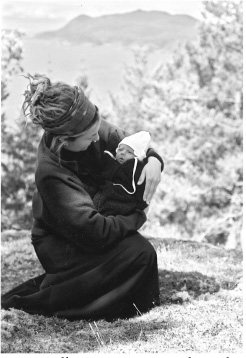
Similkameen at two weeks with
Mum on the bluff where she was
conceived!
Postscript
Five years after my birth, I became acutely ill and doctors spent over a year and a half trying to accurately diagnose my condition. In the end, it was discovered that I have a rare genetic condition called Wilson’s disease. This disease has many manifestations and symptoms, but three of them, I now realize, directly contributed to my hemorrhaging. The disease causes sufferers to have a low platelet count as well as depleted and stressed livers and kidneys. During my pregnancy, the condition had not manifested itself. I had had quite severe edema, which again in hindsight would speak to my compromised kidneys—however, I remained healthy. It was due to these added circumstances that I had such complications.
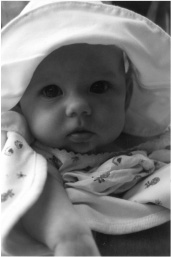
Three months old.
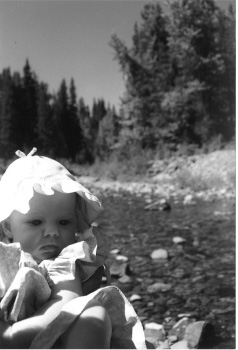
Six weeks old, Similkameen visits the Similkameen River!
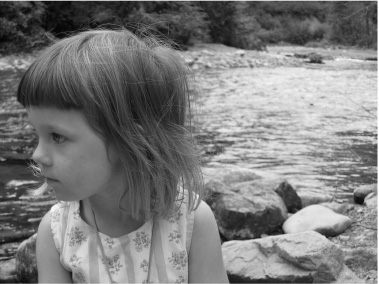
Similkameen at age three sitting on the banks of the Similkameen River.